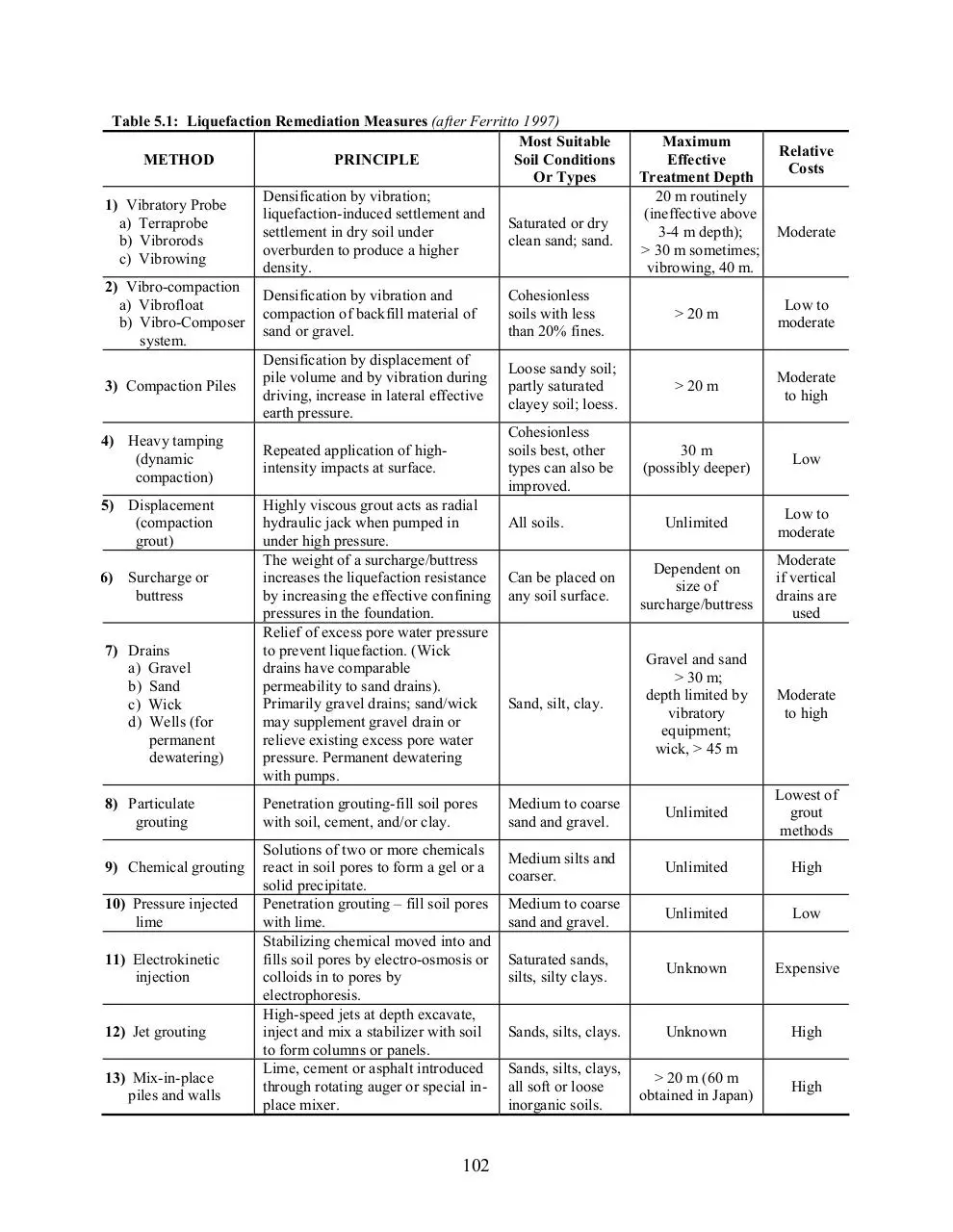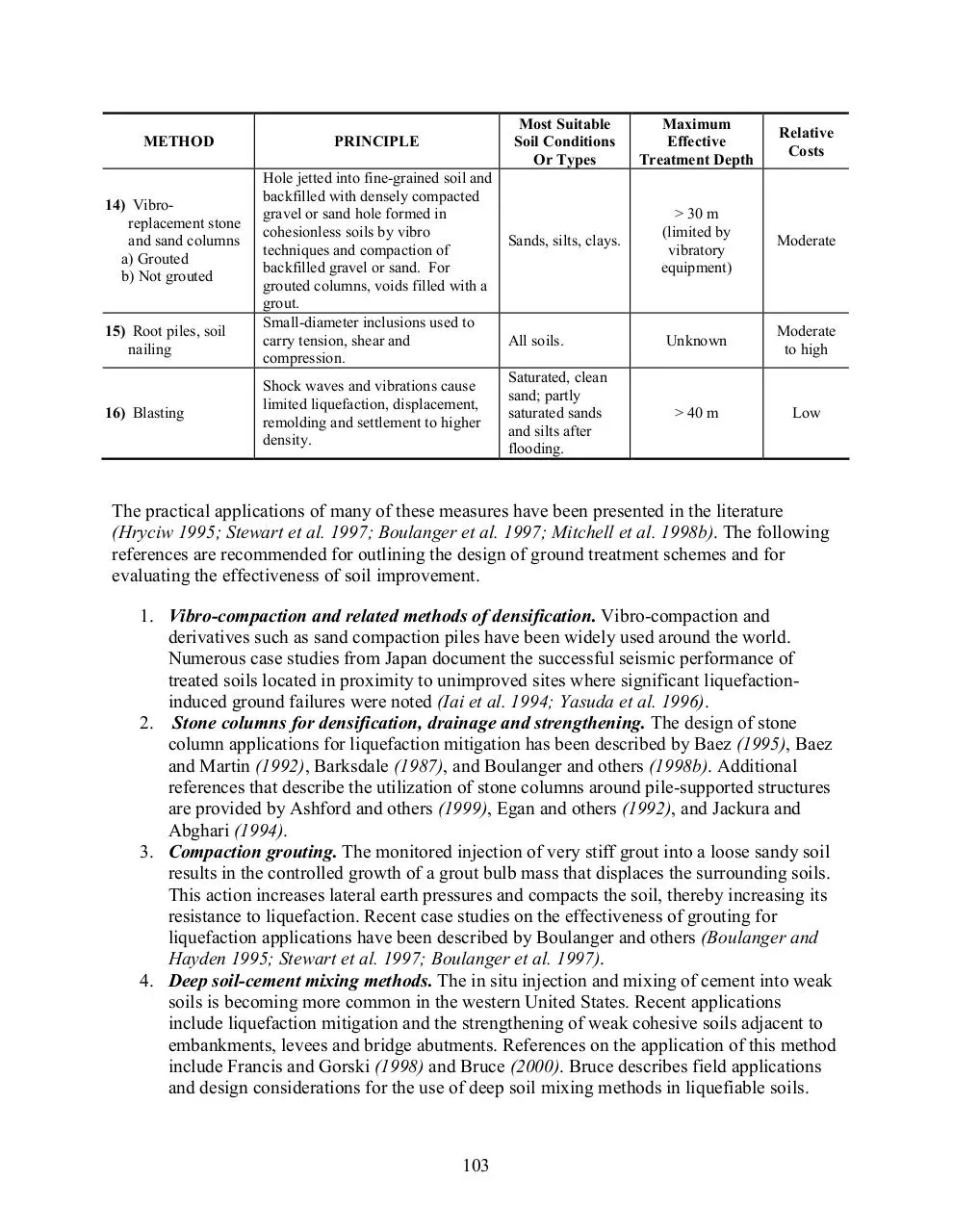METHODES LIQUEFACTION (PDF)
File information
Author: hp
This PDF 1.7 document has been generated by / Foxit PhantomPDF - Foxit Software Inc., and has been sent on pdf-archive.com on 08/02/2017 at 10:46, from IP address 46.193.x.x.
The current document download page has been viewed 578 times.
File size: 163.16 KB (2 pages).
Privacy: public file


File preview
Table 5.1: Liquefaction Remediation Measures (after Ferritto 1997)
Most Suitable
METHOD
PRINCIPLE
Soil Conditions
Or Types
Densification by vibration;
1) Vibratory Probe
liquefaction-induced settlement and
Saturated or dry
a) Terraprobe
settlement in dry soil under
clean sand; sand.
b) Vibrorods
overburden to produce a higher
c) Vibrowing
density.
2) Vibro-compaction
Cohesionless
Densification by vibration and
a) Vibrofloat
soils with less
compaction of backfill material of
b) Vibro-Composer
than 20% fines.
sand or gravel.
system.
Densification by displacement of
Loose sandy soil;
pile volume and by vibration during
partly saturated
3) Compaction Piles
driving, increase in lateral effective
clayey soil; loess.
earth pressure.
Cohesionless
4) Heavy tamping
soils best, other
Repeated application of high(dynamic
types can also be
intensity impacts at surface.
compaction)
improved.
Highly viscous grout acts as radial
5) Displacement
hydraulic jack when pumped in
All soils.
(compaction
under high pressure.
grout)
The weight of a surcharge/buttress
increases the liquefaction resistance Can be placed on
6) Surcharge or
by increasing the effective confining any soil surface.
buttress
pressures in the foundation.
Relief of excess pore water pressure
to prevent liquefaction. (Wick
7) Drains
drains have comparable
a) Gravel
permeability to sand drains).
b) Sand
Sand, silt, clay.
Primarily gravel drains; sand/wick
c) Wick
may supplement gravel drain or
d) Wells (for
relieve existing excess pore water
permanent
pressure. Permanent dewatering
dewatering)
with pumps.
8) Particulate
grouting
9) Chemical grouting
10) Pressure injected
lime
11) Electrokinetic
injection
12) Jet grouting
13) Mix-in-place
piles and walls
Penetration grouting-fill soil pores
with soil, cement, and/or clay.
Solutions of two or more chemicals
react in soil pores to form a gel or a
solid precipitate.
Penetration grouting – fill soil pores
with lime.
Stabilizing chemical moved into and
fills soil pores by electro-osmosis or
colloids in to pores by
electrophoresis.
High-speed jets at depth excavate,
inject and mix a stabilizer with soil
to form columns or panels.
Lime, cement or asphalt introduced
through rotating auger or special inplace mixer.
102
Maximum
Effective
Treatment Depth
20 m routinely
(ineffective above
3-4 m depth);
> 30 m sometimes;
vibrowing, 40 m.
Relative
Costs
Moderate
> 20 m
Low to
moderate
> 20 m
Moderate
to high
30 m
(possibly deeper)
Low
Unlimited
Low to
moderate
Dependent on
size of
surcharge/buttress
Moderate
if vertical
drains are
used
Gravel and sand
> 30 m;
depth limited by
vibratory
equipment;
wick, > 45 m
Moderate
to high
Medium to coarse
sand and gravel.
Unlimited
Lowest of
grout
methods
Medium silts and
coarser.
Unlimited
High
Medium to coarse
sand and gravel.
Unlimited
Low
Saturated sands,
silts, silty clays.
Unknown
Expensive
Sands, silts, clays.
Unknown
High
Sands, silts, clays,
all soft or loose
inorganic soils.
> 20 m (60 m
obtained in Japan)
High
METHOD
14) Vibroreplacement stone
and sand columns
a) Grouted
b) Not grouted
15) Root piles, soil
nailing
16) Blasting
Most Suitable
Soil Conditions
Or Types
PRINCIPLE
Hole jetted into fine-grained soil and
backfilled with densely compacted
gravel or sand hole formed in
cohesionless soils by vibro
Sands, silts, clays.
techniques and compaction of
backfilled gravel or sand. For
grouted columns, voids filled with a
grout.
Small-diameter inclusions used to
carry tension, shear and
All soils.
compression.
Saturated, clean
Shock waves and vibrations cause
sand; partly
limited liquefaction, displacement,
saturated sands
remolding and settlement to higher
and silts after
density.
flooding.
Maximum
Effective
Treatment Depth
Relative
Costs
> 30 m
(limited by
vibratory
equipment)
Moderate
Unknown
Moderate
to high
> 40 m
Low
The practical applications of many of these measures have been presented in the literature
(Hryciw 1995; Stewart et al. 1997; Boulanger et al. 1997; Mitchell et al. 1998b). The following
references are recommended for outlining the design of ground treatment schemes and for
evaluating the effectiveness of soil improvement.
1. Vibro-compaction and related methods of densification. Vibro-compaction and
derivatives such as sand compaction piles have been widely used around the world.
Numerous case studies from Japan document the successful seismic performance of
treated soils located in proximity to unimproved sites where significant liquefactioninduced ground failures were noted (Iai et al. 1994; Yasuda et al. 1996).
2. Stone columns for densification, drainage and strengthening. The design of stone
column applications for liquefaction mitigation has been described by Baez (1995), Baez
and Martin (1992), Barksdale (1987), and Boulanger and others (1998b). Additional
references that describe the utilization of stone columns around pile-supported structures
are provided by Ashford and others (1999), Egan and others (1992), and Jackura and
Abghari (1994).
3. Compaction grouting. The monitored injection of very stiff grout into a loose sandy soil
results in the controlled growth of a grout bulb mass that displaces the surrounding soils.
This action increases lateral earth pressures and compacts the soil, thereby increasing its
resistance to liquefaction. Recent case studies on the effectiveness of grouting for
liquefaction applications have been described by Boulanger and others (Boulanger and
Hayden 1995; Stewart et al. 1997; Boulanger et al. 1997).
4. Deep soil-cement mixing methods. The in situ injection and mixing of cement into weak
soils is becoming more common in the western United States. Recent applications
include liquefaction mitigation and the strengthening of weak cohesive soils adjacent to
embankments, levees and bridge abutments. References on the application of this method
include Francis and Gorski (1998) and Bruce (2000). Bruce describes field applications
and design considerations for the use of deep soil mixing methods in liquefiable soils.
103
Download METHODES LIQUEFACTION
METHODES LIQUEFACTION.pdf (PDF, 163.16 KB)
Download PDF
Share this file on social networks
Link to this page
Permanent link
Use the permanent link to the download page to share your document on Facebook, Twitter, LinkedIn, or directly with a contact by e-Mail, Messenger, Whatsapp, Line..
Short link
Use the short link to share your document on Twitter or by text message (SMS)
HTML Code
Copy the following HTML code to share your document on a Website or Blog
QR Code to this page

This file has been shared publicly by a user of PDF Archive.
Document ID: 0000550720.